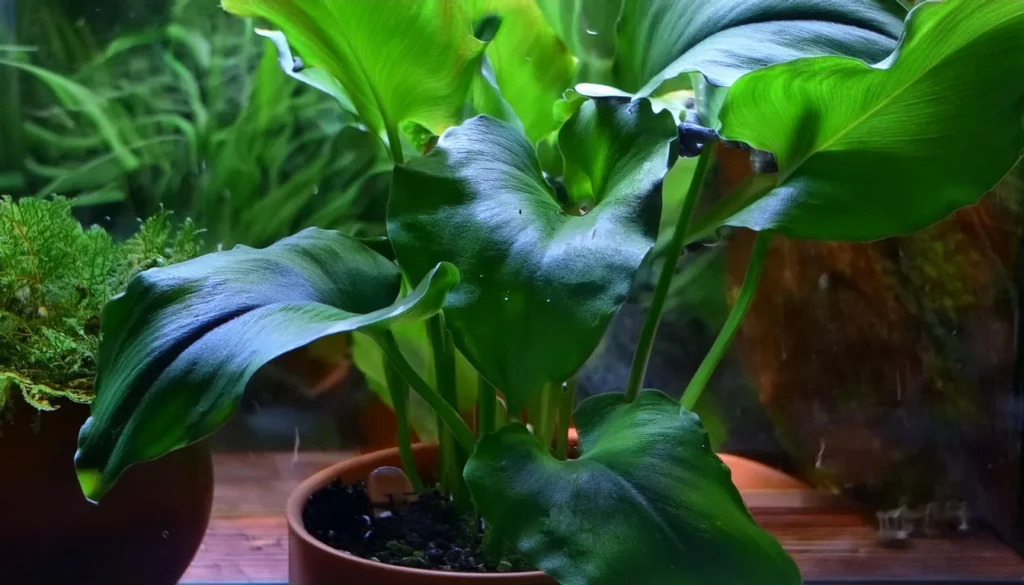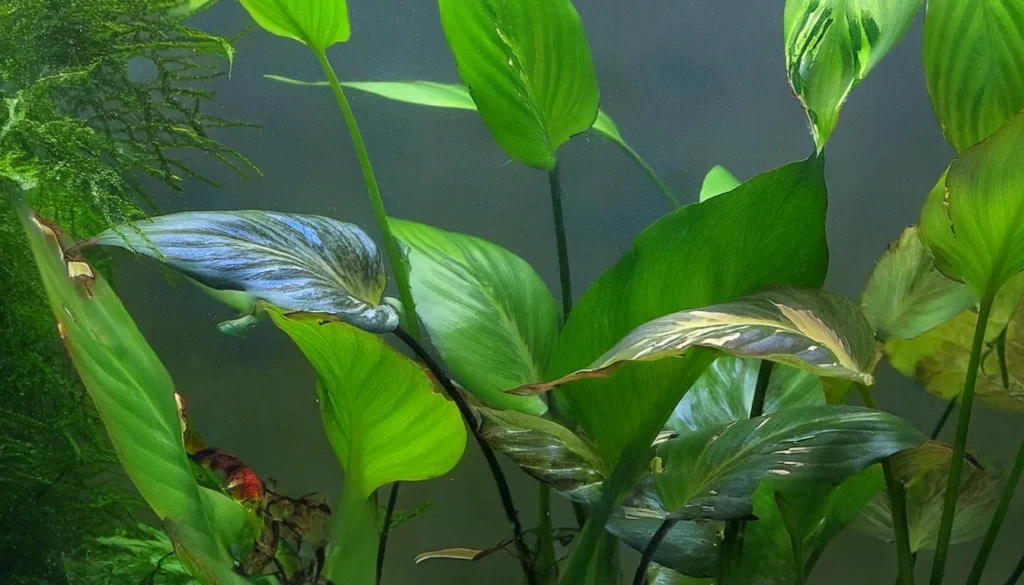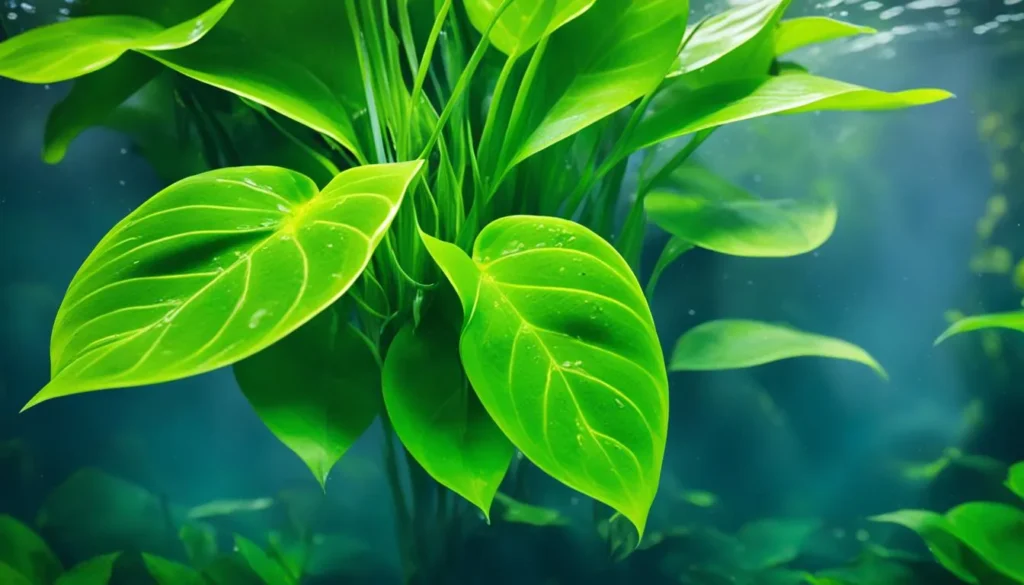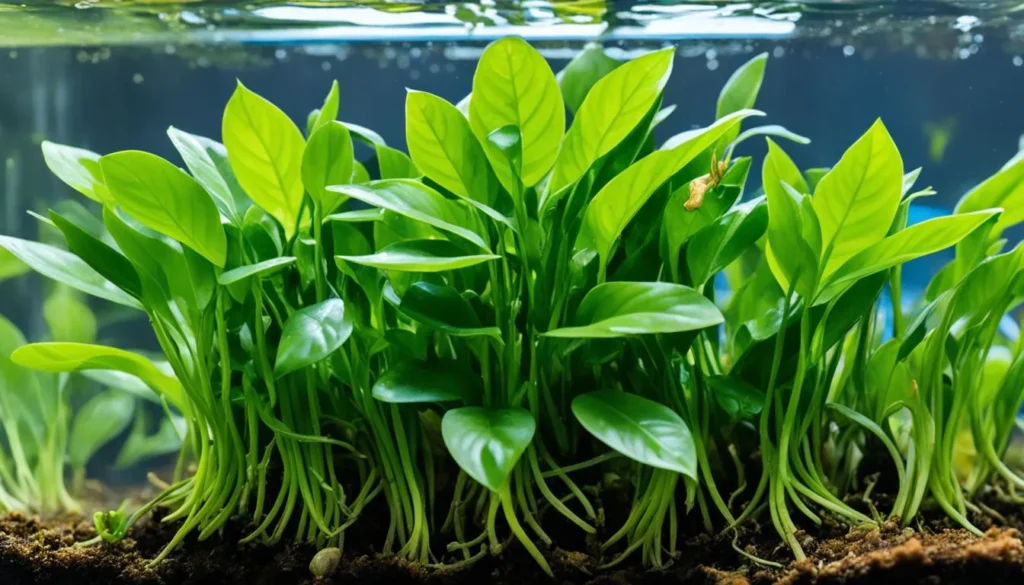Welcome to our in-depth exploration of Anubias Nangi, a captivating aquatic plant that brings beauty and versatility to freshwater aquariums.
From its unique characteristics to care tips and the benefits it provides, we will cover everything you need to know about this remarkable plant.

Anubias Nangi, scientifically known as Anubias barteri var. nana ‘Nangi,’ is a small, compact, submerged plant native to West Africa.
With its dark green, heart-shaped leaves and sturdy stems, Anubias Nangi adds a touch of elegance to any tank.
Whether you’re a seasoned aquarist or just starting, this tropical plant is a wonderful addition to your aquatic vegetation collection.
Key Takeaway
- Anubias Nangi is a stunning aquatic plant that brings beauty and versatility to freshwater aquariums.
- It is a small, compact, submerged plant with dark green, heart-shaped leaves.
- Understanding the history and requirements of Anubias Nangi is crucial for its successful growth.
- Proper care, including lighting conditions and water quality, is essential for maintaining the health and vitality of this tropical plant.
- Anubias Nangi offers aesthetic value in aquascaping and provides various benefits to aquariums, such as natural algae reduction and serving as a shelter for fish.
Quick Stats
| Attribute | Details |
| Family Name | Araceae |
| Origin | Hybrid (Anubias nana x Anubias gilletii) |
| Height | 10-25 cm (4-10 inches) |
| pH Range | 6.0 – 7.5 |
| CO2 Requirement | Low to None |
| Growth Rate | Slow to Medium |
| Care Level | Easy |
| Color Form | Green, with a slightly broader leaf than Anubias nana |
| Water Conditions | 22-28°C (72-82°F), soft to moderately hard water |
| Max Size | Leaves up to 10-15 cm (4-6 inches) long |
| Lighting | Low to Moderate |
| Supplements | Iron-rich fertilizer can benefit growth, but not essential |
| Placement | Foreground to Mid-ground |
| Propagation | Rhizome division |
What Is Anubias Nangi?
Anubias Nangi, scientifically known as Anubias barteri var. nana ‘Nangi,’ is a small and compact aquatic plant native to West Africa. It features dark green, heart-shaped leaves and sturdy stems.
With a slow growth rate and a height ranging from 5 to 10 cm, Anubias Nangi is suitable for small and large aquarium setups.
This beautiful aquatic plant adds elegance and charm to freshwater tanks, making it popular among aquarium enthusiasts.

History
- Anubias plants have a rich history in the world of freshwater aquariums. The genus Anubias, to which Anubias Nangi belongs, is native to the tropical regions of Africa.
- These plants have become favored among aquarists worldwide due to their adaptability and striking appearance.
- Over the years, Anubias plants, including Anubias Nangi, have gained popularity for their ability to thrive in a variety of aquarium setups.
- Their resilience and unique features, such as dark green leaves and sturdy stems, make them highly sought after by aquarium enthusiasts.
- As we explore the history of Anubias Nangi, we will uncover how it has captivated the hearts of aquarists and solidified its place as a beloved and versatile aquarium plant.
RELATED: Aquascaping With Anubias Barteri For A Creative Aquascape

Requirements For Growing Anubias Nangi
To ensure the successful growth of Anubias Nangi, it is important to understand its specific requirements. Meeting these requirements will create an ideal environment for your Anubias Nangi plants to thrive.
- Lighting Conditions: Anubias Nangi thrives in moderate to low lighting conditions. It is best to provide indirect or diffused lighting to prevent algae growth on the leaves. A good option is to use fluorescent or LED lights with a Kelvin rating between 5000K and 7000K.
- Water Quality: Anubias Nangi prefers clean water with balanced parameters. Maintain a pH level between 6.5 and 7.5, and a water hardness between 3 and 8 dKH. Regular 20-30% water changes every two weeks will help maintain optimal water quality.
- Temperature Preferences: Anubias Nangi thrives in temperatures between 72°F and 82°F (22°C and 28°C). Avoid extreme temperature fluctuations, which can stress the plant and hinder its growth.
- Appropriate Fertilization: Anubias Nangi is a slow-growing plant that doesn’t require intense fertilization. You can provide nutrients through fish waste and decaying organic matter in the aquarium. However, if necessary, you can use a liquid or substrate fertilizer specifically designed for aquatic plants.

Caring For Your Anubias Nangi
Proper care is essential for the longevity and beauty of Anubias Nangi.
In this section, we will provide detailed instructions on caring for your Anubias Nangi, including optimal lighting conditions for growth, maintaining water quality, and meeting the plant’s temperature preferences.
By following these care tips, you can ensure the health and vitality of your Anubias Nangi plants.
- Optimal Lighting Conditions for Growth: Anubias Nangi requires moderate to low lighting conditions for optimal growth. Direct exposure to intense sunlight or high-intensity artificial lighting can cause the leaves to burn or turn yellow. Place your aquarium in a well-lit area without direct sunlight, or use aquarium lighting replicating natural daylight. It is recommended to provide 8-10 hours of light per day to support healthy growth.
- Water Quality and Temperature Preferences: Anubias Nangi thrives in freshwater aquariums with stable water parameters. Maintain a pH level between 6.0 and 7.5, and a water temperature between 72°F and 82°F (22°C and 28°C). Regularly test the water quality using a reliable aquarium test kit and adjust as needed. Keeping the water clean and well-filtered is important to prevent the buildup of harmful substances and maintain optimal conditions for your Anubias Nangi plants.

| Lighting | Water Quality | Temperature |
| Requires moderate to low lighting conditions | Maintain stable water parameters with a pH level between 6.0 and 7.5 | Keep the water temperature between 72°F and 82°F (22°C and 28°C) |
| Avoid direct sunlight or high-intensity artificial lighting | Regularly test water quality and make adjustments as needed | Maintain a clean and well-filtered aquarium |
| Provide 8-10 hours of light per day |
Substrate And Placement Tips
- The proper substrate and placement of Anubias Nangi are crucial factors that can significantly impact its growth, health, and overall aesthetic appeal in your aquarium.
- By selecting the right substrate and strategically placing your Anubias Nangi plants, you can create a visually stunning aquascape and provide the optimal environment for their development.
- Regarding substrate options for Anubias Nangi, there are a few key considerations. Anubias Nangi is a rhizomatous plant, meaning it attaches its roots to objects like rocks or driftwood rather than burying them in the substrate.
- Therefore, a fine-grained substrate like sand or small gravel works best, as it allows the plant’s rhizome to attach and anchor securely. Avoid using large or sharp gravel that may damage the plant’s delicate roots.
- When placing Anubias Nangi in your aquarium, consider the following tips:
- Attach the rhizome to rocks or driftwood using a fishing line or aquarium plant glue. This encourages the plant to grow upward and prevents it from being uprooted by fish or water movement.
- Position the plants in areas with moderate or low light intensity. Anubias Nangi thrives in shaded areas and can tolerate low-light conditions better than many other aquatic plants.
- Avoid burying the rhizome in the substrate. Placing it too deep can cause rot and hinder the plant’s growth.
- Create a visually appealing layout by grouping Anubias Nangi plants together or combining them with other compatible aquatic plants.
RELATED: Aquascaping With Anubias Barteri For A Creative Aquascape
Propagation Techniques For Anubias Nangi
Propagation allows you to expand your collection of Anubias Nangi plants and share them with fellow aquarium enthusiasts.
In this section, we will explore various propagation techniques for Anubias Nangi, including dividing the rhizome and planting new sections.
With these techniques, you can multiply your Anubias Nangi plants and enjoy their beauty in multiple aquariums.
Anubias Nangi can be propagated using the following techniques:
- Dividing the Rhizome: The rhizome is the horizontal stem of the Anubias Nangi plant from which the leaves and roots grow. To propagate Anubias Nangi through rhizome division, carefully remove the plant from the substrate and locate the rhizome. Use a sharp, clean knife or pair of scissors to divide the rhizome into smaller sections, ensuring each section has healthy leaves and roots. Plant the divided sections in separate aquarium areas, ensuring they are securely anchored in the substrate.
Planting New Sections: Another propagation technique for Anubias Nangi involves planting new sections. This method is suitable when the plant naturally produces offsets or new shoots.
Gently detach the offset or new shoot from the parent plant, ensuring it has its own set of leaves and roots.
Plant the new section in a separate area of the aquarium, providing it with proper substrate and anchoring it securely.

| Step | Description |
| Step 1 | Gently remove the Anubias Nangi plant from the substrate. |
| Step 2 | Locate the rhizome, which is the horizontal stem. |
| Step 3 | Using a sharp, clean knife or scissors, divide the rhizome into smaller sections. |
| Step 4 | Ensure each divided section has healthy leaves and roots. |
| Step 5 | Plant the divided sections in separate areas of the aquarium. |
| Step 6 | Securely anchor the divided sections in the substrate. |
The Aesthetic Importance Of Anubias In Aquascaping
It plays a crucial role in aquascaping, where the art of creating natural underwater landscapes comes to life. Its unique beauty and versatility make it a sought-after choice for aquascapes looking to design captivating freshwater aquariums.
In this section, we will explore the aesthetic importance of Anubias Nangi in aquascaping and provide tips for crafting stunning natural aquatic landscapes that highlight its visual appeal.
Crafting Natural Aquatic Landscapes
When incorporating Anubias Nangi into your aquascape, it is essential to create a layout that mimics the natural habitats of aquatic plants. Consider the following tips:
- Use a mix of substrates, such as gravel or sand, to create depth and texture in your aquascape. This will provide a visually appealing backdrop for your Anubias Nangi.
- Arrange rocks and driftwood strategically to create natural-looking caves and crevices. These features will enhance the aesthetic appeal of your aquascape and offer hiding spots for fish.
- Combine this plant with other aquatic plants to create a harmonious balance. Consider incorporating plants with varying heights and leaf shapes to add dimension to your aquascape.
Color Contrast And Leaf Texture
Anubias Nangi boasts dark green, heart-shaped leaves that add a touch of elegance to any aquascape. Its distinct leaf texture and coloration can be used to create eye-catching contrasts within your aquarium. Here’s how:
- Pair this with lighter-colored aquatic plants to create a striking contrast. The vibrant green of the Anubias leaves will stand out against lighter-colored backgrounds, adding visual interest to your aquascape.
- Consider placing it near plants with different leaf shapes and sizes. This juxtaposition of textures creates a visually dynamic aquascape that captures attention.
- Experiment with different lighting conditions to further highlight the color and texture of Anubias Nangi. Adjustable LED lights can help you achieve the ideal lighting for showcasing its beauty.
Benefits
- Oxygenation and Water Quality Improvement: Anubias Nangi, apart from its captivating beauty, offers substantial benefits to your freshwater aquarium. One of its notable advantages is its role in oxygenation and improving water quality. Through photosynthesis, It absorbs carbon dioxide and releases oxygen, contributing to the well-being of your aquatic ecosystem. The continuous oxygen supply ensures a healthy environment for your fish and other aquatic organisms, promoting overall vitality.
- Natural Algae Reduction with Anubias Nangi: In addition to its oxygenating properties, This plant also aids in reducing algae growth in your aquarium. This aquatic plant’s dense foliage and slow growth rate inhibit the proliferation of nuisance algae by competing for nutrients and blocking excessive light. As a result, the presence of Anubias Nangi helps create a visually appealing and balanced aquatic environment, where algae-related issues are minimized and water clarity is enhanced.

Anubias Nangi As Shelter And Spawning Ground
- Anubias Nangi, as an aquatic plant, serves a crucial role in providing shelter for small fish within your freshwater aquarium. Its dense foliage and robust structure create natural hiding spots, giving your fish a sense of security.
- This promotes their overall well-being and allows them to exhibit natural behavior, reducing stress levels and enhancing their quality of life.
- Additionally, It serves as a safe spawning ground for various fish species. The plant’s broad leaves and sturdy stems offer ample surface area for fish to lay their eggs, promoting successful breeding and increasing the chances of fry survival.
- By incorporating this plant into your aquarium, you create an environment that mimics the natural habitats of fish, facilitating their reproductive processes and contributing to the sustainability of your aquatic ecosystem.
Interactive Roles: Anubias Nangi And Aquarium Inhabitants
This versatile aquarium plant, plays interactive roles with various inhabitants in your aquatic ecosystem. Let’s explore how this beautiful plant promotes natural fish behavior and provides safe havens for small fish and fry.
- Promoting Natural Fish Behavior: It encourages natural fish behavior by creating an environment that stimulates foraging and grazing. The plant’s broad, luscious leaves provide a natural grazing surface for herbivorous fish, allowing them to mimic their feeding habits in the wild. As fish interact with this plant, their behavior becomes more authentic, contributing to a healthy and engaging aquarium environment.
- Safe Havens for Small Fish and Fry: It offers safe havens for small fish and fry, providing them with shelter and protection. The plant’s dense foliage creates secluded spaces where delicate and vulnerable fish can hide from larger, more aggressive tank mates. These safe havens enhance the survival rate of young fish and contribute to a harmonious ecosystem within your aquarium.
Conclusion
This plant is a beautiful and versatile aquatic plant that is perfect for enhancing the elegance of your freshwater aquarium.
Throughout this article, we have explored the unique characteristics and benefits of incorporating it into your aquatic setup.
By following the care guidelines provided, you can ensure the health and vitality of your Anubias Nangi plants.
Paying attention to their specific lighting, water quality, and temperature requirements will create an ideal environment for their growth.
Additionally, proper placement and substrate selection will contribute to the visual appeal of your aquascape.
This plant not only provides aesthetic beauty but also offers a range of benefits to your aquarium. This versatile plant naturally oxygenates the water and helps improve overall water quality.
Its ability to reduce algae growth adds to your aquatic environment’s cleanliness and visual attractiveness.
Furthermore, Anubias Nangi serves as a refuge and spawning ground for fish, promoting natural behavior and contributing to their well-being.
Frequently Asked Question
How Can I Encourage More Vigorous Growth In Anubias Nangi?
Although it is inherently a slow grower, you can encourage more vigorous growth by ensuring it has optimal growing conditions. Moderate lighting will support photosynthesis without encouraging excessive algae growth on its leaves.
Supplementing the water column with liquid fertilizers, especially those rich in micronutrients, can benefit leaf health and growth. While CO2 supplementation is not necessary, it can slightly enhance growth and plant vitality. Ensure the rhizome is not buried in the substrate to prevent rot and encourage better nutrient absorption.
What Is The Best Way To Propagate Anubias Nangi For A Healthy, Robust Offspring?
Propagation of Anubias nangi is best achieved by rhizome division. Use a sharp, clean knife or scissors to carefully divide the rhizome, ensuring each piece has at least 2-3 leaves and a portion of healthy roots.
This method minimizes stress on the parent plant and ensures each new plantlet has the resources it needs to grow independently. After cutting, attach each rhizome section to driftwood or rocks using fishing line, cotton thread, or aquarium-safe super glue to prevent it from floating away and to encourage root attachment.
Can Anubias Nangi Thrive In Both Submerged And Emersed Conditions, And What Are The Key Considerations For Each?
It can thrive in both submerged and emersed conditions. In submerged setups, it’s crucial to maintain clean water and moderate lighting to prevent algae growth on leaves.
Emersed cultivation requires maintaining high humidity levels around the plant, as Anubias nangi’s leaves can dry out if exposed to low humidity.
Emersed growth often leads to faster growth rates and can stimulate flowering. Whichever method you choose, ensure the rhizome remains above the substrate to prevent rot.
What Are Effective Measures To Combat Algae On Anubias Nangi Without Damaging The Plant?
To combat algae on it, first ensure that your aquarium lighting is not too intense or prolonged, as excess light is a primary cause of algae growth. Algae eaters like Otocinclus catfish or Amano shrimp can be introduced to naturally control algae levels.
For manual removal, gently rub the leaves with a soft toothbrush or cloth. If needed, dip the leaves in a diluted hydrogen peroxide solution for a few minutes before rinsing them off and returning the plant to the aquarium, keeping the rhizome from soaking to avoid damage.
How Does The Hybrid Nature Of Anubias Nangi Affect Its Care Requirements Compared To Its Parent Species?
It combines traits from both Anubias gilletii and Anubias barteri var. nana, resulting in a plant that is versatile and adaptable to a range of aquarium conditions. Like its parent species, It prefers moderate lighting and can grow in both submerged and emersed setups.
Its care requirements are generally similar, prioritizing clean water, avoiding direct substrate burial of the rhizome, and providing nutrients through the water column. The hybrid nature of this plant doesn’t significantly complicate its care but offers an aesthetic and robustness that’s appreciated in planted aquariums.
- Unveiling The Wonders Of Riccia Fluitans In Aquascapes - August 7, 2024
- Vallisneria Gigantea Var. Guide To Care And Cultivation At Home - July 31, 2024
- Vesicularia Dubyana Care & Growth Guide Tips For Beginner Gardeners - July 30, 2024
